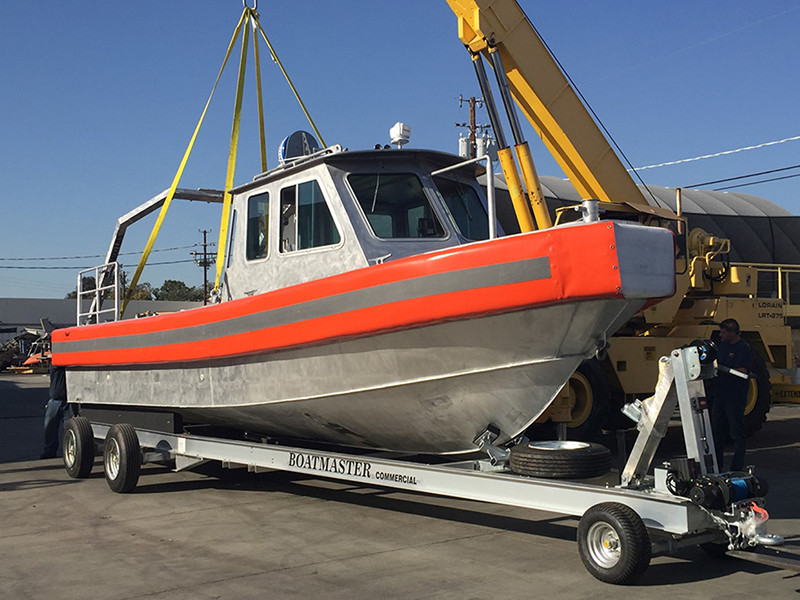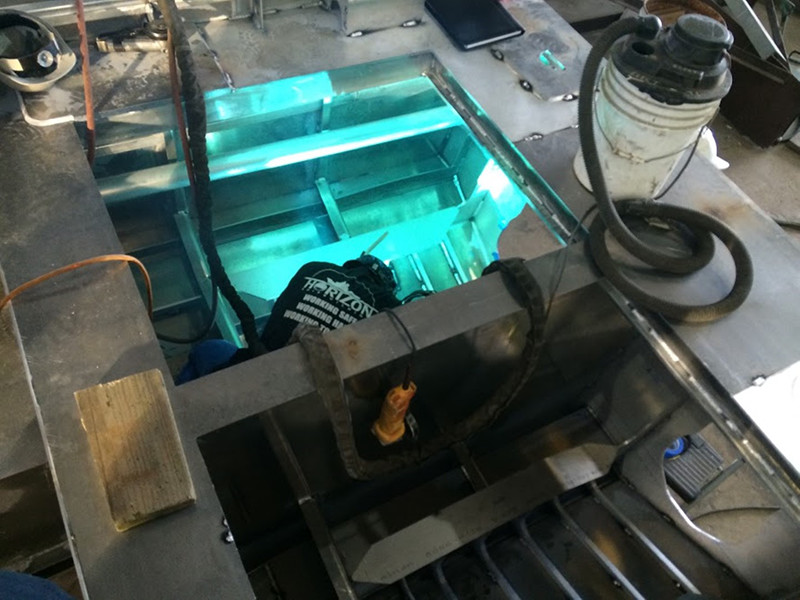
Photo Credit: Ethan Norris
|
The new Rigid Hull Inflatable Boats were tested off the coast of Long Beach, California, prior to their
deployment to Palmer Station.
|
Bigger Boats, Better Science
New boats for Palmer Station should dramatically increase the capabilities of researchers working there.
By Michael Lucibella, Antarctic Sun Editor
Posted October 14, 2016
Two new boats on their way to Palmer Station will soon allow researchers to dramatically extend their time out on the water, and the distance away from station they’re able to travel while reducing their risk and exposure to the elements.

Photo Credit: Ethan Norris
Marine Tech Ross Hein tests a swing arm that will be used to deploy equipment off the side of the boat.
The new Rigid Hull Inflatable Boats (RHIBs), scheduled to arrive in the coming months, will complement the fleet of smaller boats already at the station. “We’re really expanding the area around Palmer Station where scientists can collect seawater, sample the seafloor, or conduct net tows for important mid-water organisms,” said Tim McGovern, ocean projects manager in the National Science Foundation’s Division of Polar Programs. The division manages the U.S. Antarctic Program.
These new boats come as the result of a recommendation in the 2012 U.S. Antarctic Program Blue Ribbon Panel on future directions of the program.
Though the new 34-foot-long RHIBs will be both faster and have larger fuel tanks, it’s their safety features that really extend the range of research around the station.

Photo Credit: Ethan Norris
A shipbuilder works on the hull of one of the RHIBs what it was being built in Alabama.
“One of the main safety concerns is being out far away from station and having someone get hypothermia from being exposed to the elements for long periods of time,” said Ethan Norris, Antarctic Program marine area manager.
The inflatable boats and the landing craft presently at the station are all open-platform vessels, meaning there’s no protection from the weather. Crews stay relatively close to the station so they can return to shelter quickly should a storm move through. The RHIBs however have an enclosed compartment protected from the elements.
“That is one piece of it that allows you to be able to stay out and go out further and longer,” Norris said. “Now we can cut [their return] time in half and we can also put that person inside where there’s a heated space.”
With the enclosed area, crews should be able to stay out on the water for up to 18 hours and be able to spend more time collecting samples and deploying scientific instruments. Previously, with the open platform boats, researchers were limited to about six hours in the boats.
In addition, the larger boats will be better designed for scientists to collect samples from the ocean. The winches on the back of the boats will be able to tow much heavier loads in the water, so researchers can tow and trawl for fish, krill and crabs, or take sediment cores from the bottom of the sea, even when the larger research vessels aren’t in the area.

Photo Credit: Ethan Norris
After a series of successful tests and trial runs, the two RHIBs are scheduled to arrive at Palmer Station in March and June respectively.
Though it has inflatable in the name, the hulls of the new boats are not inflatable in the same sense that the boats already operating out of Palmer Station are. “The rigid hull inflatables have a hard bottom allowing it to be a sturdier platform. It gives it the rigidity required to operate heavy equipment over the side,” Norris said. “The inflatable portion of it is the pontoon around the side.”
That inflatable pontoon, which is also partially filled with foam, helps to stabilize the boat in choppy seas and helps keep the boat afloat if it’s damaged and taking on water. Much of the research at Palmer Station is focused on oceanography and the biology of the adjacent waters. With no airfield, boats are the primary means of transport from the remote station to the nearby islands.
“Palmer Station is primarily a maritime station. It’s a maritime station where scientists go out and collect samples from the ocean and provide that long term feedback of what is happening in that ecosystem,” Norris said. “This will help them provide that same data hopefully more quickly and more reliably.”
The first of the new boats is scheduled to arrive at the station sometime in March, and the second in June.








